-
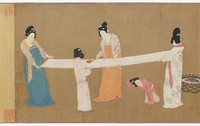 Court Ladies Preparing Newly Woven Silk
Court Ladies Preparing Newly Woven Silk
-
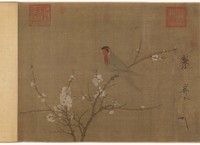 Five-colored Parakeet on a Blossoming Apricot Tree
Five-colored Parakeet on a Blossoming Apricot Tree
-
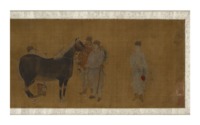 Judging a Horse
Judging a Horse
-
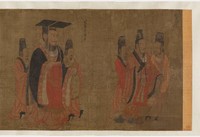 The Thirteen Emperors
The Thirteen Emperors
-
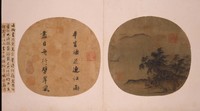 Sailboat in Rainstorm
Sailboat in Rainstorm
-
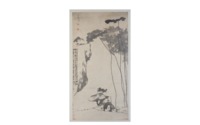 Lotus and Ducks
Lotus and Ducks
-
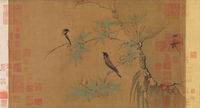 Finches and Bamboo
Finches and Bamboo Huizong was the eighth emperor of the Song dynasty and the most artistically accomplished of his imperial line. Finches and Bamboo exemplifies the realistic style of flower-and-bird painting practiced at Huizong’s academy. Whether making a study from nature or illustrating a line of poetry, however, the emperor valued capturing the spirit of a subject over literal representation. Here the minutely observed finches are imbued with the vitality of their living counterparts. Drops of lacquer added to the birds’eyes impart a final lifelike touch.
-
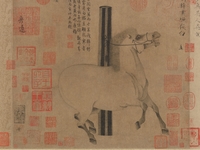 Night-Shining White
Night-Shining White A leading horse painter of the Tang dynasty, Han Gan was known for capturing not only the likeness of a horse but also its spirit. This painting, the most famous work attributed to the artist, is a portrait of a charger of Emperor Xuanzong (r. 712–56). With its burning eye, flaring nostrils, and dancing hoofs, the fiery-tempered horse epitomizes Chinese myths about Central Asian "celestial steeds" that "sweated blood" and were actually dragons in disguise. The seals and inscriptions added to the painting and its borders by later owners and appreciators are a distinctive feature of Chinese collecting and connoisseurship. The addition of more than one thousand years of seals and comments offers a vivid testimony of the work's transmission and its impact on later generations.
The acquisition of this image, arguably the greatest equine portrait in Chinese painting, marked the Director's early commitment to revitalizing the Department of Asian Art under the curatorial leadership of Wen Fong and with the dedicated support of trustee Douglas Dillon.
-
 Wang Xizhi Watching Geese
Wang Xizhi Watching Geese After the fall of Hangzhou, the Southern Song capital, in 1276, the artist Qian Xuan chose to live as an yimin, a “leftover subject” of the dynasty. Painted in his deliberately primitive “blue-and-green” style, this handscroll illustrates the story of Wang Xizhi ( 303 – 361), the calligraphy master of legendary fame and a practitioner of Daoist alchemy, who was said to derive inspiration from natural forms such as the graceful neck movements of geese. In creating a dreamlike evocation of antiquity, the artist prevented a realistic reading of his picture space as a way of asserting the disjuncture he felt after the fall of the Song royal house.
-
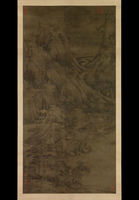 Riverbank
Riverbank During the chaotic years following the collapse of the Tang dynasty in 907, centralized rule was shattered and China splintered into a number of short-lived kingdoms. Among the most important of these was the Southern Tang dynasty (937–75), which governed much of the lower Yangzi River delta from its capital at Nanjing. It was there that a distinctive “southern” style of landscape painting developed under the court official and artist Dong Yuan.
 Court Ladies Preparing Newly Woven Silk
Court Ladies Preparing Newly Woven Silk
 Five-colored Parakeet on a Blossoming Apricot Tree
Five-colored Parakeet on a Blossoming Apricot Tree
 Judging a Horse
Judging a Horse
 The Thirteen Emperors
The Thirteen Emperors
 Sailboat in Rainstorm
Sailboat in Rainstorm
 Lotus and Ducks
Lotus and Ducks
 Finches and Bamboo Huizong was the eighth emperor of the Song dynasty and the most artistically accomplished of his imperial line. Finches and Bamboo exemplifies the realistic style of flower-and-bird painting practiced at Huizong’s academy. Whether making a study from nature or illustrating a line of poetry, however, the emperor valued capturing the spirit of a subject over literal representation. Here the minutely observed finches are imbued with the vitality of their living counterparts. Drops of lacquer added to the birds’eyes impart a final lifelike touch.
Finches and Bamboo Huizong was the eighth emperor of the Song dynasty and the most artistically accomplished of his imperial line. Finches and Bamboo exemplifies the realistic style of flower-and-bird painting practiced at Huizong’s academy. Whether making a study from nature or illustrating a line of poetry, however, the emperor valued capturing the spirit of a subject over literal representation. Here the minutely observed finches are imbued with the vitality of their living counterparts. Drops of lacquer added to the birds’eyes impart a final lifelike touch. Night-Shining White A leading horse painter of the Tang dynasty, Han Gan was known for capturing not only the likeness of a horse but also its spirit. This painting, the most famous work attributed to the artist, is a portrait of a charger of Emperor Xuanzong (r. 712–56). With its burning eye, flaring nostrils, and dancing hoofs, the fiery-tempered horse epitomizes Chinese myths about Central Asian "celestial steeds" that "sweated blood" and were actually dragons in disguise. The seals and inscriptions added to the painting and its borders by later owners and appreciators are a distinctive feature of Chinese collecting and connoisseurship. The addition of more than one thousand years of seals and comments offers a vivid testimony of the work's transmission and its impact on later generations. The acquisition of this image, arguably the greatest equine portrait in Chinese painting, marked the Director's early commitment to revitalizing the Department of Asian Art under the curatorial leadership of Wen Fong and with the dedicated support of trustee Douglas Dillon.
Night-Shining White A leading horse painter of the Tang dynasty, Han Gan was known for capturing not only the likeness of a horse but also its spirit. This painting, the most famous work attributed to the artist, is a portrait of a charger of Emperor Xuanzong (r. 712–56). With its burning eye, flaring nostrils, and dancing hoofs, the fiery-tempered horse epitomizes Chinese myths about Central Asian "celestial steeds" that "sweated blood" and were actually dragons in disguise. The seals and inscriptions added to the painting and its borders by later owners and appreciators are a distinctive feature of Chinese collecting and connoisseurship. The addition of more than one thousand years of seals and comments offers a vivid testimony of the work's transmission and its impact on later generations. The acquisition of this image, arguably the greatest equine portrait in Chinese painting, marked the Director's early commitment to revitalizing the Department of Asian Art under the curatorial leadership of Wen Fong and with the dedicated support of trustee Douglas Dillon. Wang Xizhi Watching Geese After the fall of Hangzhou, the Southern Song capital, in 1276, the artist Qian Xuan chose to live as an yimin, a “leftover subject” of the dynasty. Painted in his deliberately primitive “blue-and-green” style, this handscroll illustrates the story of Wang Xizhi ( 303 – 361), the calligraphy master of legendary fame and a practitioner of Daoist alchemy, who was said to derive inspiration from natural forms such as the graceful neck movements of geese. In creating a dreamlike evocation of antiquity, the artist prevented a realistic reading of his picture space as a way of asserting the disjuncture he felt after the fall of the Song royal house.
Wang Xizhi Watching Geese After the fall of Hangzhou, the Southern Song capital, in 1276, the artist Qian Xuan chose to live as an yimin, a “leftover subject” of the dynasty. Painted in his deliberately primitive “blue-and-green” style, this handscroll illustrates the story of Wang Xizhi ( 303 – 361), the calligraphy master of legendary fame and a practitioner of Daoist alchemy, who was said to derive inspiration from natural forms such as the graceful neck movements of geese. In creating a dreamlike evocation of antiquity, the artist prevented a realistic reading of his picture space as a way of asserting the disjuncture he felt after the fall of the Song royal house. Riverbank During the chaotic years following the collapse of the Tang dynasty in 907, centralized rule was shattered and China splintered into a number of short-lived kingdoms. Among the most important of these was the Southern Tang dynasty (937–75), which governed much of the lower Yangzi River delta from its capital at Nanjing. It was there that a distinctive “southern” style of landscape painting developed under the court official and artist Dong Yuan.
Riverbank During the chaotic years following the collapse of the Tang dynasty in 907, centralized rule was shattered and China splintered into a number of short-lived kingdoms. Among the most important of these was the Southern Tang dynasty (937–75), which governed much of the lower Yangzi River delta from its capital at Nanjing. It was there that a distinctive “southern” style of landscape painting developed under the court official and artist Dong Yuan.